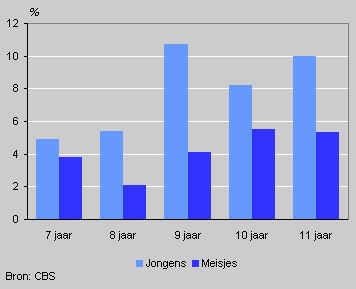How are the children?

There are almost 2.5 million children under the age of twelve in the Netherlands. Are they growing up with brothers and sisters? Are they going to day-care centres? What do children do in their spare time? Are they healthy?
Family situation
Most children grow up in two-parent families. About 97 percent of children aged between 0 and 4 live with two parents. This figure is 91 percent for children aged between 4 and 12.
Most children aged between 8 and 12 are part of a family with parents and one brother or sister. Almost as many children live with two parents and two or more siblings. Only 6 percent of all children is an only child with two parents.
8- to 12 year olds by number of parents and siblings, 2002

Increasing numbers of children spend part of the week in child care because both parents are working. The day care or baby-sitting facilities are used for 61 percent of all babies. Child care is organised for four in five 2 to 3-year-olds. At this age many children go to playgroups.
The use of child care diminishes once the children are in school. One in fifteen children aged between 4 and 12 go to child care after school.
To school early
Although children are legally obliged to go school at the age of five, 98 percent already start at the age of four. In the school year 2002/’03 over 1.5 million children went to elementary school.
Some children require extra attention because of their background. They are called disadvantaged pupils. The share of disadvantaged pupils has been falling from 37 percent in 1997 to 26 percent in 2003. The decrease can be contributed solely to the decrease in the number of Dutch students with less-well-educated parents.
Much sport
After school two thirds of all children are active in clubs. Sport is a favourite pastime for children: 85 percent of all children between 4 and 12 participate in sports at least an hour a week. Watching television is also a major leisure activity. Six out of ten children aged between 4 and 12 spend ten hours a week or more watching TV.
Boys more often dyslectic
During their first four years of life, nine in ten babies and toddlers regularly visit the child health clinic. Frequent chronic diseases among the children are asthma and eczema.
Dyslectic children aged between 7 and 12, 2001/2002

About 4 percent of all children between 7 and 8 suffers from dyslexia. This is 7 percent among children aged between 9 and 12. Boys are dyslectic twice as often as girls.
About 5 percent of all children between 2 and 12 are hyperactive (ADHD).
Mirjam van Baal, Anita Botterweck